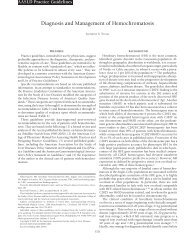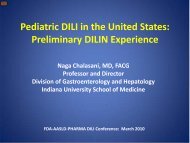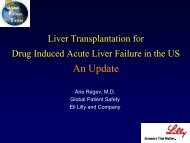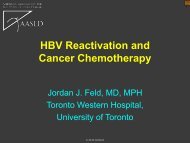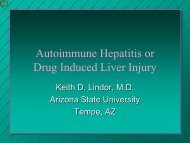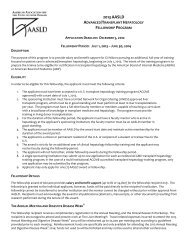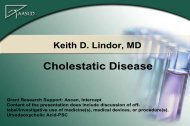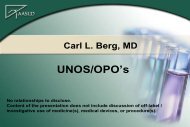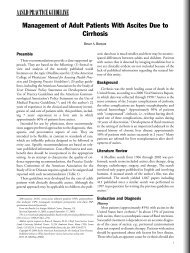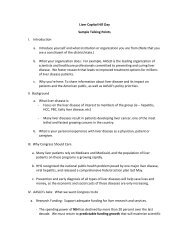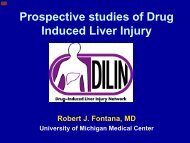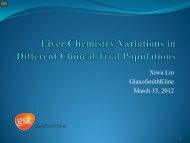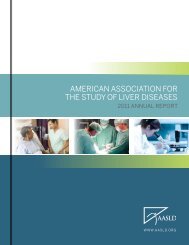Medical Treatment of Hepatorenal Syndrome - AASLD
Medical Treatment of Hepatorenal Syndrome - AASLD
Medical Treatment of Hepatorenal Syndrome - AASLD
Create successful ePaper yourself
Turn your PDF publications into a flip-book with our unique Google optimized e-Paper software.
Thomas D. Boyer, MD<strong>Hepatorenal</strong> <strong>Syndrome</strong>No relationships to disclose.Content <strong>of</strong> the presentation does not include discussion <strong>of</strong> <strong>of</strong>f-label /investigative use <strong>of</strong> medicine(s), medical devices, or procedure(s).
<strong>Hepatorenal</strong> syndromeThomas D Boyer, MDUniversity <strong>of</strong> Arizona
Conflicts <strong>of</strong> interest• Member advisory board for Orphantherapeutics-makers <strong>of</strong> terlipressin• Off label drugs• Terlipressin• Octreotide• Midodrine
Cirrhosis Evolves Clinically FromCompensated to DecompensatedStage• Compensated cirrhosis• Cirrhosis without complications• Median survival >12 years• Decompensated cirrhosis• Cirrhosis with complications: ascites(± HRS), variceal hemorrhage, jaundice, orencephalopathy• Annual rate <strong>of</strong> decompensation <strong>of</strong> 4-5%• Median survival ~1.5 yearsD'Amico G, et al. J Hepatol. 2006;44:217–231.
Pathogenesis <strong>of</strong> Ascites in CirrhosisCirrhosisIntrahepatic resistancePortal (sinusoidal) hypertensionSplanchnic vasodilatationEffective arterial blood volumeActivation <strong>of</strong> neurohumoral systemsAscitesSodiumretention
Common Pathogenesis in RefractoryAscites, Hyponatremia, and HRSCirrhosisIntrahepatic resistancePortal (sinusoidal) hypertensionSplanchnic/systemic vasodilatationEffective arterial blood volumeActivation <strong>of</strong> neurohumoral systemsSodiumretentionWaterretentionRenalvasoconstrictionAscitesRefractoryascitesHyponatremiaHRS
7060504030252015105Neurohumoral Systems AreMaximally Activated in HRSPlasma renin activity(ng/mL-h)80070060050040030025020015010050Plasma aldosterone activity(ng/dL)0HealthyCirrhosis Cirrhosis with asciteswithout without withascites renal renalfailure failure0Healthy CirrhosiswithoutascitesCirrhosis with asciteswithout withrenal renalfailure failureGines A, et al. Gastroenterology. 1993;105:229–236.
Causes <strong>of</strong> Renal Dysfunctionin Cirrhosis•Acute•Hypovolemia• Diuretics• Gastrointestinal bleed• Diarrhea (lactuloseinduced)•Nephrotoxic drugs• Aminoglycosides• Nonsteroidal antiinflammatorydrugs• Contrast agents•Sepsis•Acute kidney injury•<strong>Hepatorenal</strong> syndrome•Chronic•Glomerulonephritis• Hepatitis B• Hepatitis C•IgA nephropathy(alcoholic)•Diabetic nephropathy
Type and Frequency <strong>of</strong> Injury inAcute Renal Failure in CirrhosisTypeATN (ischemic)Hypovolemia<strong>Hepatorenal</strong> syndromeNephrotoxic DrugsObstructionFrequencyCommonVery commonRelativelycommonCommonVery uncommon
Typical Urinalysis in RenalCausePrerenalHypovolemiaHRSIntrinsicATNAINAGDysfunction in CirrhosisOsmolality(mOsm/kg)>500>500
Workup <strong>of</strong> Renal Dysfunction in Patients withCirrhosisAcute renal failure (SCr >1.5)No AscitesWith ascitesNot HRSEvidence <strong>of</strong> organicrenal failureGet urinalysis, urine electrolytes,renal ultrasoundRule out sepsis/SBPANDStop diuretics/nephrotoxic drugsVolume expansionDecrease in SCrNo responseNot HRSHRSSBP = Spontaneous bacterial peritonitisScr = Serum Creatinine
<strong>Hepatorenal</strong> syndrome1. Hepatic insufficiency and portalhypertension2. Low GFR (< 40 ml/min) or creatinine> 1.5 mg/dl3. No shock, bacterial infection, fluid lossand current or recent treatment withnephrotoxic drugs4. No sustained improvement afterwithdrawal <strong>of</strong> diuretics and infusion <strong>of</strong>1.5 liters <strong>of</strong> saline5. Proteinuria <strong>of</strong> < 500 mg/dl andnegative renal ultrasound
<strong>Hepatorenal</strong> syndromeAdditional Criteria• Urine volume < 500 ml/d• Urine sodium < 10 meq/L• Urine osmolality > plasma• Urine RBCs < 50/hpf• Serum sodium < 130 meq/L
<strong>Hepatorenal</strong> syndrome• Type 1-Doubling <strong>of</strong> serum creatinineto > 2.5 mg/dl in less than 2 weeks.• Type 2-Moderate but steady decreasein renal function to creatinine > 2.5mg/dl.
Type 1 HRS Is Associated WithVery Poor Survival1.0.8Median SurvivalType 1 = 1.7 weeksType 2 = 6 monthsSurvivalprobability.6.4.20Type 2P = .001Type 10 3 4 6 8 10 12Time (months)Gines P, et al. Lancet. 2003;362:1819–1827
Cumulative Probability <strong>of</strong> Patients WithAscites and Cirrhosis Developing HRSProbability <strong>of</strong>developing HRS.6.5.4.3.2.1Probability <strong>of</strong> HRS1 year: 19%5 years: 39%00 1 2 3 4 5YearsGines A, et al. Gastroenterology. 1993;105:229–236.
Who Develops HRS?•Cirrhotic patients with ascites• May be preceded by precipitating factor• Spontaneous bacterial peritonitis (SBP)• Sepsis• Total paracentesis• Upper GI hemorrhage•Patients with acute alcoholic hepatitis•Patients with acute liver failure
Risk <strong>of</strong> Developing RenalDysfunction in Patients with50Cirrhosis403027%33%20107%0After GIbleedingAlcoholichepatitisCardenas A, et al. Hepatology. 2001;34:671–676Akriviadis E, et al. Gastroenterology. 2000;119:1637–1648Sort P, et al. N Engl J Med. 1999;341:403–409.Spontaneousbacterialperitonitis
Prevention <strong>of</strong> HRS
Use <strong>of</strong> Albumin in SBPPlasma reninactivity (PRA)(ng/mL/hr)25201510Cefotaxime plus albuminCefotaxime without albumin* P < .001** P < .005* * **500 3 6 9DaySort P, et al. N Engl J Med. 1999;341:403–409
Antibiotic Prophylaxis in VaricealBleeding504540*ControlAntibiotic prophylaxisFrequency <strong>of</strong>infections(%)3530252015** P < .05*1050All infectionsSpontaneous bacterialperitonitis (SBP)DeathBernard B, et al. Hepatology. 1999;29:1655–1661.
Vasoconstrictors andVasodilators in HRS• Vasodilators• PG• Nitric oxide• Kallikrein-Kinin system• Glucagon• Vasoconstrictors• Endothelins• AVP• NE• Renin
Prostaglandin Inhibition andEffects on Renal Function160Creatinineclearance(mL/min)1208040BaselineImmediately afterindomethacin24 hours after lastindomethacin dose0Ascites No ascitesChange in creatinine clearance after indomethacinBoyer TD, et al. Gastroenterology. 1979;77:215–222.
•Aggressive treatment <strong>of</strong> hypotension dueto bleeding•Early treatment <strong>of</strong> sepsis and spontaneousbacterial peritonitis (SBP)•Use <strong>of</strong> albumin• SBP• Large-volume paracentesis•Avoidance <strong>of</strong> nephrotoxic drugs such asaminoglycoside antibiotics and NSAIDs•Caution <strong>of</strong> use with contrast dyePrevention <strong>of</strong> Renal Dysfunctionin Cirrhosis
<strong>Treatment</strong> <strong>of</strong> HRS General• Stop all diureticsMeasures• Look for nephrotoxic drugs• Examine urine for white cells andcasts• Perform renal ultrasound• Give 1.5 liters saline/albumin• Treat infection
<strong>Treatment</strong> HRS• Dialysis• TIPS• Liver Transplantation• Vasoactive compounds
Site <strong>of</strong> Action <strong>of</strong> CurrentTherapies for HRSCirrhosisLiver transplantationTIPSPortal (sinusoidal)hypertensionSplanchnic/systemic vasodilatationEffective arterial blood volumeActivation <strong>of</strong> neurohumoral systemsVasoconstrictors+AlbuminRenalvasoconstrictionHRSTIPS, transjugular intrahepatic portosystemic shunt.
Renal ReplacementTherapy for HRS•No controlled studies <strong>of</strong> hemodialysis inHRS 1•Hemodialysis does not confer long-termsurvival without transplantation 2•Hemodialysis may be <strong>of</strong> benefit asbridge to transplantation for patientswith HRS 3 1. Gines P, et al. Nephrology. 1999;10:1833–1839.2. Witzke O, et al. J Gastroenterol Hepatol. 2004;19:1369–1373.3. Capling RK, et al. Ren Fail. 2004;26:563–568.
TIPS and HRSGut 47:166; 2000
TIPS for HRS:<strong>AASLD</strong> Practice Guidelines• Small uncontrolled trials• No comparative survival benefit shown• Common complications• TIPS thrombosis (10–15%)• TIPS occlusions/stenosis (18–78%)• Hepatic encephalopathy (20–31%)‣Not recommended for treatment <strong>of</strong> HRS,especially type 1,•pending the publication <strong>of</strong> controlled trials<strong>AASLD</strong>, American Association for the Study <strong>of</strong> Liver Diseases.Boyer TD, et al. Hepatology. 2005;41:386–400.
<strong>Treatment</strong> <strong>of</strong> HRS:Pharmacologic Therapy
Vasoconstrictors PlusAlbumin for HRSCirrhosisPortal (sinusoidal)hypertensionSplanchnic/systemic vasodilatationEffective arterial blood volumeVasoconstrictors+AlbuminActivation <strong>of</strong> neurohumoral systemsRenalvasoconstrictionHRS
Background (II)• Synthetic 12-aminoacid peptideH• Pro-drug, with pharmacologic activity<strong>of</strong> its ownGlyGlyGlyGlyGlyCysCysTyrTyrPhePhe• Constrictive activity via V1-receptors• vascular & extravascular smooth musclecellsGlyGlyProLysLysCysCysAsnAsnGlnGln• Splanchnic vasoconstriction↓ portal flow↓ portal pressureH 2 NTerlipressin• Systemic vasoconstriction↑ effective blood volume↓ renin and angiotensin renal vasodilatation improvement in serum creatinine
SummaryEndpoint Terlipressin Placebo P-valueAll patients N = 56 (%) N = 56 (%)<strong>Treatment</strong> success day 14 14 (25) 7 (12.5) 0.093HRS reversal 19 (33.9) 7 (12.5) 0.008Received > 3 days Rx N = 36 N = 39<strong>Treatment</strong> success day 14 14 (38.9) 7 (17.9) 0.046HRS reversal 19 (52.8) 7 (17.9) 0.002
Reversal <strong>of</strong> HRS40HRS Reversal (%)30201001 3 5 7 9 11 13 15DayTerlipressinPlacebo
Terlipressin produced a significantimprovement in serum creatinine0.80.60.4Mean Change FromBaseline +/- SE0.20.0-0.2-0.4-0.6-0.81 2 3 4 5 6 7 8 9 10 11 12 13 14Day= Terlipressin = PlaceboChange from Baseline to End <strong>of</strong> <strong>Treatment</strong> in Serum Creatinine(ITT Population with Last Observation Carried Forward)
Survival DistributionFunction1.00.90.80.70.60.50.40.30.20.10.0P-value:Impact <strong>of</strong> Reversal <strong>of</strong> HRS onTransplant-Free Survival0 14(0.001)30(0.004)60(0.003)Survival (Days)90(0.001)= Censored = HRS Reversal = No HRS Reversal
Survival DistributionFunction1.00.90.80.70.60.50.40.30.20.10.0P-value:Transplant-Free Survival 90 Days0 14(0.875)30(0.477)60(0.991)Survival (Days)= Censored = Terlipressin = Placebo90(0.784)
Adverse EventsTerlipressinN=56PlaceboN=55Adverse Events 93 % 89 %Related 32 % 22 %Serious AEs 66 % 66 %Related 9 % 2 %Deaths 48 % 49 %Related 0 % 0 %Withdrawals due to AE 5 % 4 %Related 5 % 0 %
Midodrine plus Octreotideplus albumin in HRS type 1Test 0 10 20daysCreat. 5.0 4.6 3.3RPF 61 82 181Aldo. 1349 636 379PRA 17 8 5Hepatology 29:1690;1999
Impact <strong>of</strong> OLTx on RenalGlomerular filtration rate (mL/min)1009080706050403020100FunctionHRSNo HRSPretransplant 30 days 90 days 1 yearGonwa TA, et al. Transplantation. 1991;51:428–430.
HRS conclusions• HRS is a common complication <strong>of</strong> cirrhosis• Patients with HRS have a poor prognosis• Aggressive treatment <strong>of</strong> infections and use<strong>of</strong> albumin may reduce the risk <strong>of</strong>developing HRS• Do not use nephrotoxic drugs in patientswith cirrhosis
HRS conclusions continued• Exclusion <strong>of</strong> other causes <strong>of</strong> renal failureimportant in management decisions• Type 1 HRS• Refer OLTx center• May wish to try vasopressors plus albumin• Type 2 HRS• Consider use <strong>of</strong> TIPS• Refer OLTx center
Thank you



